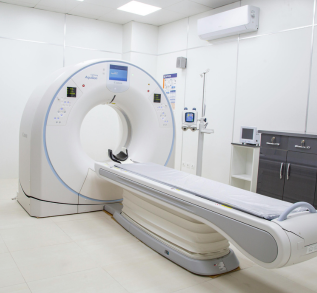
What Actually Is a CT Scan?
A CT scan, short for computed tomography scan, is a type of medical imaging test that allows doctors to see detailed pictures of the inside of your body. It combines a series of X-ray images taken from different angles and uses computer processing to create cross-sectional images of bones, blood vessels, and soft tissues. At West Kent Cardiology Partnership, we often use CT scans to assess the heart and blood vessels in great detail.
How Does a CT Scan Work?
A CT scanner is a large, doughnut-shaped machine. You lie on a table that slowly moves through the scanner while the X-ray tube rotates around you. The machine captures multiple X-ray images, which are then processed by a computer to form a 3D image of the area being examined.
Unlike a standard X-ray, which provides a single image, a CT scan offers a much clearer and more detailed view. This helps doctors identify abnormalities that might not show up on regular X-rays or other imaging tests.
When Is a CT Scan Used?
CT scans are used for a range of medical reasons, from checking injuries to investigating internal health conditions. In cardiology, they are particularly useful for examining the heart, blood vessels, and lungs.
Common uses of a CT scan include:
- Assessing heart and coronary artery health (often through a CT coronary angiogram)
- Detecting calcium build-up in arteries
- Identifying blood clots, aneurysms, or structural heart problems
- Guiding further treatment or surgery
- Evaluating chest pain or shortness of breath
For patients under our care, a CT scan can provide crucial information that helps guide diagnosis and treatment plans more accurately.
What Happens During the Scan?
The process is usually quick and painless, lasting between 10 and 30 minutes. Before the scan, you may be asked to change into a hospital gown and remove jewellery or metal objects.
In some cases, a contrast dye is injected into a vein, usually in your arm. This helps certain areas, like blood vessels or organs, show up more clearly on the scan. The dye can make you feel warm or give you a metallic taste for a few seconds this is normal and passes quickly.
You will need to lie still while the machine takes images. The radiographer will operate the scanner from a separate room but can see and talk to you throughout the procedure.
Are CT Scans Safe?
CT scans use X-rays, which involve a small amount of radiation. For most people, the benefits of having the scan outweigh any risks. The radiation exposure from a CT scan is slightly higher than that from a standard X-ray, but it is carefully controlled and kept as low as possible.
If you are pregnant or think you might be, always tell your doctor or radiographer before the scan. For children or people requiring multiple scans, doctors consider alternative imaging methods such as ultrasound or MRI to reduce exposure.
For more on safety, the NHS provides clear guidance on CT scans.
Preparing for a CT Scan
In most cases, there’s little preparation needed. You can eat and drink normally unless your doctor tells you otherwise. If a contrast dye is being used, you might be asked to avoid eating for a few hours beforehand.
Make sure to tell your doctor if you:
- Have any allergies (especially to iodine or contrast dye)
- Have kidney problems or diabetes
- Are pregnant or breastfeeding
These details help ensure the procedure is carried out safely and effectively.
CT Scans in Cardiology
At West Kent Cardiology Partnership, CT scans play a vital role in modern heart care. The CT coronary angiogram is particularly useful for detecting narrowing or blockages in the coronary arteries one of the main causes of chest pain and heart attacks.
This non-invasive test can sometimes prevent the need for more invasive procedures, such as traditional coronary angiography. It helps us:
- Detect early signs of coronary artery disease
- Monitor heart conditions
- Plan treatments or lifestyle changes based on detailed results
By using CT scans alongside other diagnostic tests like echocardiograms or ECGs, we can build a clear picture of your heart health.
What Happens After the Scan?
After your scan, you can usually go home straight away. If you were given a contrast dye, it’s important to drink plenty of fluids to help flush it out of your system.
Your scan results will be reviewed by a radiologist or cardiologist. They’ll interpret the images and send a report to the doctor who requested the scan. You’ll then be contacted to discuss the findings and next steps, if any.
If the scan was carried out as part of a heart assessment, the results will guide your ongoing care plan whether that means lifestyle advice, medication, or further investigations.
Benefits of a CT Scan
Some of the main advantages of CT scans are listed simply below for you
- Clarity: Provides highly detailed images of internal structures
- Speed: Produces results quickly, which is vital in urgent cases
- Accuracy: Helps diagnose a wide range of conditions
- Non-invasive: Usually requires no recovery time
- Guidance: Supports treatment planning and surgery
Conclusion
A CT scan is an invaluable tool in modern medicine, especially in cardiology. It allows doctors to see the heart and surrounding structures in precise detail, supporting early diagnosis and effective treatment.
If you have concerns about your heart health or symptoms like chest pain or breathlessness, speak to your GP or a cardiology specialist. At West Kent Cardiology Partnership, we use CT scanning and other advanced diagnostic methods to help assess and manage heart conditions safely and accurately.
To learn more or to book an appointment, you can contact us here once our online booking link is available. For trusted information on CT scans, visit the British Heart Foundation.

